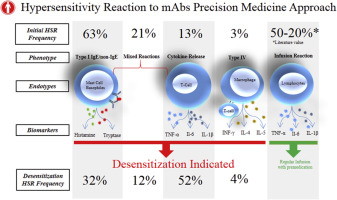Journal of Allergy and Clinical Immunology ( IF 14.2 ) Pub Date : 2018-03-05 , DOI: 10.1016/j.jaci.2018.02.018 Ghislaine Annie C. Isabwe , Marlene Garcia Neuer , Leticia de las Vecillas Sanchez , Donna-Marie Lynch , Kathleen Marquis , Mariana Castells

|
Background
The increasing use of mAbs has led to a rise in hypersensitivity reactions (HSRs), which prevent their use as first-line therapy. HSRs' symptoms, diagnostic tools, and directed management approaches have not been standardized.
Objective
We propose a novel evidence-based classification of HSRs to mAbs, based on the clinical phenotypes, underlying endotypes and biomarkers, as well as their management with desensitization.
Methods
Phenotypes, endotypes, and biomarkers of HSRs to 16 mAbs for 104 patients were described and compared with the outcomes of 526 subcutaneous and intravenous desensitizations.
Results
Initial reactions presented with 4 patterns: type I–like reactions (63%), cytokine-release reactions (13%), mixed reactions (21%), and delayed type IV reactions (3%). In contrast, of the 23% breakthrough HSRs during desensitization, 52% were cytokine-release reactions, 32% were type 1, 12% were mixed, and 4% were type I with delayed type IV. Skin testing to 10 mAbs in 58 patients was positive in 41% of patients. Serum tryptase was elevated in 1 patient and IL-6 was elevated in 8 patients during desensitization and was associated with a cytokine-release phenotype.
Conclusions
HSRs to mAbs can be defined as type I, cytokine-release, mixed (type I/cytokine-release), and type IV reactions, which are identified by biomarkers such as skin test, tryptase, and IL-6. These phenotypes can be used to improve personalized and precision medicine when diagnosing HSRs to mAbs and providing management recommendations with desensitization. Desensitization provides a safe and effective retreatment option to remain on culprit mAbs as first-line therapy.
中文翻译:

对治疗性单克隆抗体的超敏反应:表型和内型
背景
单克隆抗体的使用增加导致超敏反应(HSR)增多,这阻止了它们作为一线治疗的用途。高铁的症状,诊断工具和定向管理方法尚未标准化。
客观的
我们基于临床表型,潜在的内在型和生物标志物,以及通过脱敏对它们的管理,提出了一种新的基于证据的HSR对mAb的分类。
方法
描述了104位患者的HSR表型,内型和生物标志物对16 mAb的影响,并将其与526皮下和静脉脱敏的结果进行了比较。
结果
初始反应表现为4种类型:类I型反应(63%),细胞因子释放反应(13%),混合反应(21%)和延迟型IV型反应(3%)。相反,在脱敏过程中23%的突破性高铁中,有52%是细胞因子释放反应,32%是1型,12%是混合型,4%是I型并延迟了IV型。对58位患者的10 mAb的皮肤测试在41%的患者中呈阳性。在脱敏过程中,1名患者的血清类胰蛋白酶升高,8名患者的IL-6升高,并与细胞因子释放表型有关。
结论
单克隆抗体的HSR可以定义为I型,细胞因子释放,混合(I型/细胞因子释放)和IV型反应,这些反应可以通过生物标志物(例如皮肤试验,类胰蛋白酶和IL-6)进行鉴定。这些表型可用于诊断针对单抗的HSR并为脱敏提供管理建议,从而改善个性化和精密医学。脱敏为一线治疗提供了一种安全有效的再治疗方法,可保留在罪魁祸首mAb上。



























 京公网安备 11010802027423号
京公网安备 11010802027423号